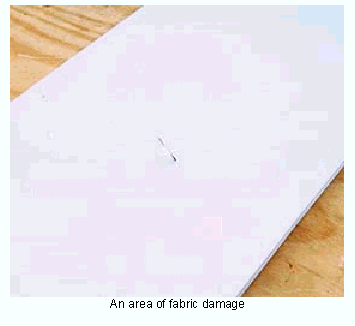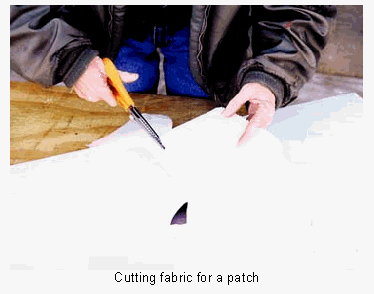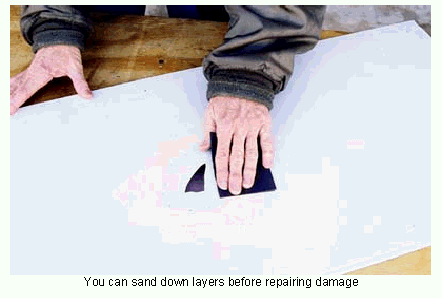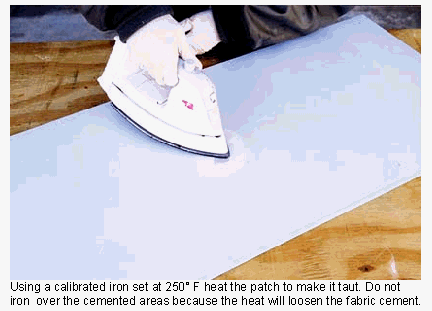Repairing Ceconite Fabric - Dealing with casual and major damage
By Ron Alexander (originally published in EAA Sport Aviation, October 2000)
We discussed the repair of damaged Poly-Fiber fabric and coatings in the September Aircraft Building. This month we’ll address the repair of Ceconite fabric covered with nitrate and butyrate dope. Butyrate dope surfaces are fairly easy to repair, as you will discover, and the final topcoat of butyrate dope will allow you to blend in the color of the repair to the point that it is barely visible.
Before we begin, remember that if you own an amateur-built airplane, you can legally repair it-fabric damage included. If you’ve not done any fabric work before, it’s a good idea to have someone familiar with fabric techniques, such as a qualified airframe and powerplant (A&P) mechanic, inspect the area and recommend a repair.
If you own a production airplane, you can repair damaged fabric under the supervision of an A&P mechanic who will endorse the airplane’s maintenance records, saying that the repair was done properly. Repairs that require structural work are major damage and are a matter for an A&P mechanic’s hands-on work.
Doped Ceconite
Ceconite fabric may be coated with nitrate and butyrate dope or with a polyurethane-covering system. We’ll focus on the repair of doped Ceconite and briefly touch on dope coatings that have a topcoat of automotive polyurethane. To repair Ceconite fabric using polyurethane systems, refer to the covering manual for the particular system.
The method of fabric repair depends on the size of the damaged area. You can repair small areas with a patch, but large tears or rips require sewing the fabric. The Ceconite manual gives the proper fabric repair methods, and it refers to FAA Advisory Circular 43-13-1B, Acceptable Methods, Techniques, and Practices-Aircraft Inspection and Repair, for repairs involving major damage. Major damage is any area more than 16 inches long. It calls areas less than 16 inches casual damage, and you can repair it two ways, with a doped-in patch or a sewn-in patch.
Doped-In Repairs
Repairing casual damage, which must be less than 16 inches in length, with a doped-in patch is limited to aircraft with a never-exceed speed (VNE) of less than 150 mph. Your first repair step is to remove the butyrate dope down to the nitrate layers around the damaged area. If the damage is less than 8 inches long, include an area for a 2-inch patch overlap. If the damage is more than 8 inches but less than 16 inches, you’ll need to remove the butyrate dope for a 4-inch overlap all the way around the damage.
Removing the butyrate dope down to the nitrate dope layer is important. Nitrate is the first dope applied to Ceconite because butyrate dope doesn’t adhere to any polyester fabric. In the same vein, nitrate dope doesn’t adhere to butyrate dope, so you must remove all the butyrate dope around the damaged area.
You can remove the coats of butyrate dope two ways-by sanding or by soaking the area with butyrate thinner. Depending on the size of the damaged area, sanding may be easier. Start with 280-grit sandpaper. You’ll have to sand almost down to bare fabric to make sure you’ve removed all the butyrate dope.
First you’ll sand through the color coats and then through the silver coats. Both of these should be pigmented butyrate dope-one with a color pigment and the other with a silver pigment. Ascertaining when you’ve reached the nitrate dope layers is difficult, so keep sanding until you are just about to bare fabric. (If you actually reach bare fabric, so much the better.)
Using a clean rag to soak the damaged area with butyrate thinner is another way to remove the butyrate layers. After the thinner has done its work, you can remove the dope with a putty knife or dull blade. Before you soak the dope, carefully mask the area around the damage to keep from removing any more dope than necessary. Using this method is risky because it’s easy to damage the fabric, and you need to take care to not cut the good fabric with the dull blade.
After removing the dope, cut your patch out of new fabric after carefully measuring the dope-free area. Use pinking shears and make sure the patch is of the same weight fabric that is on the airplane and that it has the required overlap. To prevent future frustration, cut the patch from very smooth fabric because it’s difficult to remove wrinkles.
With your patch cut, glue it in place using Ceconite Super Seam fabric cement. The patch’s pinked edges give it a greater gluing surface compared to a straight cut. Make sure you apply glue to the entire overlap area. Let the glue dry thoroughly (at least one hour), then use a calibrated iron set at 250° F to heat tauten the patch. Do not iron over the cemented areas because the heat will loosen the fabric cement.
Next put finishing tapes (usually a 2-inch width) over the area. If the tear was small and you were able to sew it together, put the finishing tape directly over the sewn area. If you had to sew in a new piece of fabric, then apply the finishing tape over the sewn seams used to attach this new fabric. Attach the tapes with nitrate dope, Classic Prep, or Rand-O-Proof. You’ll probably need to thin any of these chemicals slightly to brush them in place, but do not thin them too much because it reduces their adhesion capability.
After brushing the finishing tapes in place, reapply all of the chemical coats necessary to build up the area to match the dope layers on the surrounding fabric. Brush on at least two coats of nitrate dope over the patches and tapes, then brush or spray two coats of clear butyrate dope, followed by several coats of silver butyrate dope. Apply enough silver coats to bring the repaired area up to the level of the old coatings. After the dope has dried, sand it smooth, and apply the final color coats of butyrate dope. After the color coats are dry you can then polish the area to blend in with the old dope.
Sewn-In Repairs
Sewn-in repairs are required for aircraft with a VNE of 150 mph or more, but they are often used instead of doped-in repairs on all aircraft. You must use Ceconite hand-sewing thread for the repair. Using a 3-inch or 6-inch curved needle will save you time and frustration.
After removing the dope down to the nitrate layer, you’re ready to start sewing. AC 43-13-1B gives the type of stitch you should use. If the damage is a small tear, you’ll be able to sew it closed with a baseball stitch. If you cannot sew the damaged fabric closed, you’ll need to sew in a new section of fabric. Cut this patch from a new, unshrunken piece of smooth fabric using straight shears (so the pinked edges will not appear under the finishing tape).
After neatly sewing the patch in place using the baseball stitch, shrink the patch with a calibrated iron set to 250° F. The remaining steps are the same as a doped-in repair. Apply finishing tapes over the sewn seams and rebuild the layers of nitrate and butyrate dope.
Repairing Major Damage
Major fabric damage is a tear or hole larger than 16 inches. Because repairing damage of this magnitude often requires you to re-cover the entire panel or surface, the FAA considers it a major alteration or repair. When you’re working on a production airplane, this means an A&P mechanic must submit FAA Form 337 (AC 43-13-1B gives the details).
Generally, on an airplane with a VNE of less than 150 mph, you can repair a tear longer than 16 inches using a patch with a 4-inch overlap and 4-inch finishing tapes. If the airplane’s VNE is greater than 150 mph, you must have a 4-inch patch overlap and use 6-inch wide finishing tapes over the seam and centered on the edge of the patch.
As always, make sure there is no underlying structural damage. If there is, don’t repair it unless you have the necessary skills. On a production airplane, an A&P mechanic must perform or supervise all repairs.
Polyurethane Topcoat
Using automotive polyurethane topcoats on fabric isn’t advisable because it’s too brittle to adhere to polyester fabric (like Ceconite or Poly-Fiber). The topcoat often shows signs of cracking within five years, and while the fabric itself is in good shape, the cracked paint begins to separate from the underlying layers. Fabric-covering companies and distributors regularly field questions from customers asking how they can fix the cracking and separating problem. The short answer is one people do not want to hear: re-cover the airplane.
Still, a number of fabric-covered aircraft flying today have an automotive polyurethane topcoat, and if the fabric is damaged, you can repair it. But before making the repair, you must remove all the paint from the damaged area. Do not use a paint stripper. Many of the new strippers not only remove the paint, but they also remove the finishing tapes and weaken fabric cemented seams. In addition, they leave a residue on the fabric that makes re-coating a real nightmare.
So, what should you do? Remove the polyurethane paint by peeling it off with a putty knife or by blasting air from an air gun. Sanding is also an option. You can sand down through the paint layers to the underlying coats and then repair the fabric as previously discussed.
If you encounter large areas where the topcoat is peeling and cracking, completely re-covering the area will probably be the best fix. Usually it’s easier to re-cover than to try to get large areas of problem topcoats off of the fabric.
I’ve seen some airplanes where you can peel off all chemical coats down to bare fabric. If you can remove all of the chemicals down to bare fabric, you have a chance of salvaging the fabric. Use MEK to thoroughly clean the bare fabric and then re-coat using the proper chemicals and procedures.
When repairing fabric, follow the recommendations given in the covering system’s manual to the letter. The Ceconite manual gives instructions for covering an airplane using nitrate and butyrate dope, and it details the repair procedures discussed here. You can easily repair Ceconite fabric if you have all the necessary tools and materials, a copy of the manual, and the supervision or know-how before you begin.
Tools & Materials
You’ll need the tools and materials listed below to repair Ceconite fabric coated with nitrate and butyrate dope. You should acquire these items before starting the repair, and you should use the same weight of fabric originally used on the airplane. That weight should be noted in the airframe logbook.
- Small piece of fabric
- Masking tape and paper
- Small glue brush
- 2-inch brush
- Pinking shears
- 3-inch curved needle
- Iron
- Thermometer to calibrate iron
- Pencil
- Small touch-up spray gun
- 280-grit sandpaper
- Rags
- Gloves
- Goggles
- Super Seam cement
- MEK
- Nitrate dope
- Butyrate dope (clear)
- Butyrate dope (silver)
- Butyrate topcoat (color)




